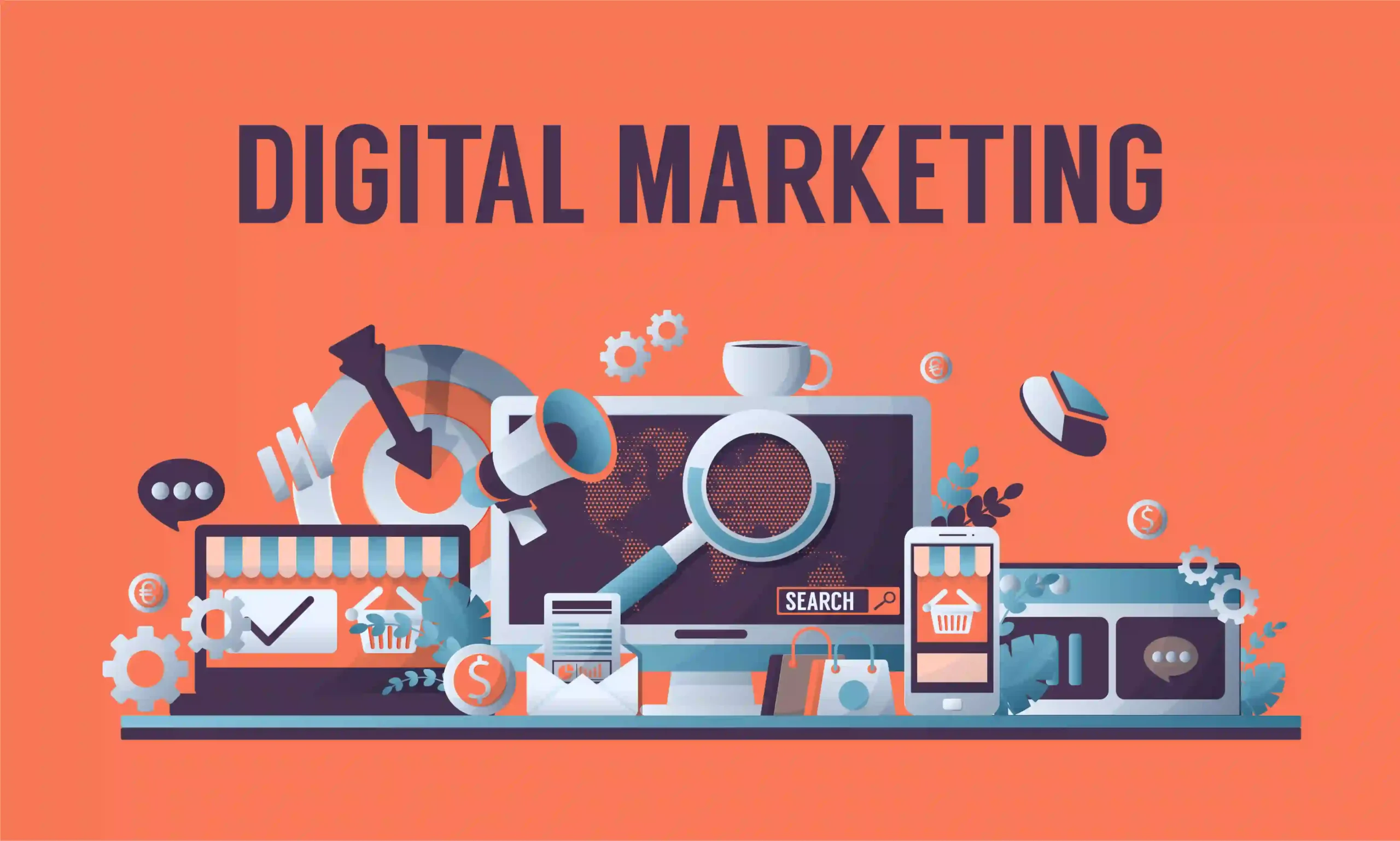Key Takeaways:
- Continuous evolution of social media algorithms, search engine protocols, and digital trends necessitates marketers to stay vigilant, update their knowledge, and adapt strategies.
- Marketers must keep abreast of social media and search engine algorithm adjustments to maintain content visibility and engagement.
- Staying informed about the latest digital trends and integrating relevant innovations into marketing strategies is crucial for engaging the target audience.
- Adopting a proactive, agile approach to strategy development, including regular analysis and A/B testing, is essential for effective engagement and conversion.
- The rapid pace of change in digital marketing requires a commitment to ongoing learning and professional development.
- Organizations need to strategically allocate resources, focusing on high-ROI activities and leveraging cost-effective platforms to maximize their digital marketing efforts.
- Segmenting the audience and leveraging data analytics are key to tailoring marketing strategies that resonate with diverse groups.
- Developing and implementing a compelling content strategy involves understanding the audience, setting clear objectives, creating high-quality content, and measuring success.
In the fast-paced world of digital marketing, keeping up with the latest trends and overcoming the myriad of challenges is crucial for any marketer aiming to stay ahead in the game. As we delve into 2024, the digital marketing landscape continues to evolve, bringing new hurdles and opportunities. This article explores these challenges and offers insights into effective solutions, ensuring marketers can navigate this complex field with greater ease.
What is Digital Marketing? How it Works
Before we tackle the challenges, let’s define digital marketing. At its core, digital marketing involves promoting products or services through digital channels to reach consumers. This broad term encompasses various strategies and platforms, including social media, email, search engines, and websites, to connect with potential customers. The essence of digital marketing lies in its ability to use data and technology to target specific segments of the audience, offering personalized and engaging content that drives conversions.
Common Digital Marketing Challenges

Dynamic Platform
The dynamic nature of digital marketing platforms presents a formidable challenge to marketers, primarily due to the continuous evolution of social media algorithms, search engine protocols, and overall digital trends. This ever-changing landscape requires marketers to remain vigilant and flexible, constantly updating their knowledge and strategies to ensure their content remains visible and engaging to their target audience.
Understanding Algorithm Changes
Social media platforms such as Facebook, Instagram, and Twitter periodically adjust their algorithms to improve user experience, filter content, and prioritize certain types of interactions. These adjustments can significantly affect how and to what extent content reaches its intended audience. Marketers must keep abreast of these changes and understand their implications to tweak their content strategy accordingly. Failure to adapt can result in decreased content visibility and engagement, negatively impacting overall digital marketing efforts.
Adapting to Search Engine Updates
Similarly, search engines like Google frequently update their ranking algorithms to provide more relevant and high-quality search results to users. These updates can dramatically shift website traffic patterns overnight. Marketers must continuously optimize their websites and content for search engines, a process known as search engine optimization (SEO), to maintain or improve their rankings in search results. This involves a deep understanding of current SEO best practices, such as keyword research, quality content creation, and effective link-building strategies.
Navigating Digital Trends
Digital trends can shape user behavior and expectations, influencing how audiences interact with content and platforms. Marketers must stay informed about the latest digital trends and integrate relevant innovations into their strategies. This could mean leveraging new social media features, adopting emerging technologies like augmented reality for more immersive experiences, or understanding the growing importance of privacy and data protection in digital interactions.
Strategy Adaptation and Testing
To navigate the challenges posed by the dynamic nature of digital platforms, marketers need to adopt a proactive and agile approach to strategy development. This involves regular analysis of campaign performance data, willingness to experiment with new tactics, and the flexibility to pivot strategies based on real-time feedback and results. A/B testing, for example, becomes a crucial tool in determining the effectiveness of different approaches and identifying the most effective tactics for engaging the target audience.
Continuous Learning and Development
Finally, the rapid pace of change in digital marketing necessitates a commitment to continuous learning and professional development. Marketers must invest time and resources into staying updated with the latest tools, technologies, and methodologies. This can involve participating in industry workshops, webinars, and conferences, as well as engaging with a community of digital marketing professionals to share insights and best practices. overcoming the challenges posed by the dynamic nature of digital marketing platforms requires marketers to be adaptable, informed, and strategic. By understanding the impact of algorithm changes, adapting to search engine updates, staying ahead of digital trends, continuously testing and refining strategies, and committing to ongoing learning, marketers can navigate these challenges effectively and maintain a competitive edge in the digital landscape.
Limited Budget
Limited budget constraints are a common challenge for many organizations attempting to navigate the digital marketing landscape. This issue necessitates careful and strategic planning to ensure that available funds are allocated in the most efficient manner possible, aiming to maximize return on investment (ROI) across various campaigns and platforms. Here’s how organizations can tackle this challenge:
Strategic Budget Allocation
The key to overcoming budget limitations lies in strategic allocation of resources. Organizations must prioritize their digital marketing efforts based on objectives that align closely with their overall business goals. This involves identifying which platforms and campaigns are most likely to reach their target audience effectively and generate the desired outcomes, whether that’s brand awareness, lead generation, or direct sales.
Focus on High-ROI Activities
Focusing on digital marketing activities that offer the highest ROI can help organizations make the most of their limited budgets. This often means leveraging organic search strategies, such as SEO, which, while requiring time to build momentum, can provide sustained traffic and lead generation over time without the ongoing costs associated with paid advertising. Content marketing is another area where businesses can see a significant return, particularly if they create valuable, evergreen content that continues to attract visitors long after it’s published.
Utilize Cost-Effective Platforms
Not all digital marketing platforms require a hefty budget. Social media platforms, for example, can be used effectively with minimal financial investment. By creating engaging content and leveraging organic growth tactics, such as hashtags and community engagement, organizations can build a substantial presence without spending heavily on paid advertising. Additionally, email marketing remains one of the most cost-effective digital marketing strategies, offering direct communication with customers and prospects at a relatively low cost.
Implement Performance Tracking and Analytics
To ensure that every dollar spent is working as hard as possible, organizations must implement robust performance tracking and analytics. This enables marketers to monitor the effectiveness of their campaigns in real-time, adjust strategies as needed, and allocate budget more efficiently towards the highest-performing initiatives. Tools like Google Analytics and various social media analytics platforms provide valuable insights into campaign performance, audience behavior, and conversion metrics.
Leverage Creative and Innovative Tactics
Budget constraints often necessitate creativity and innovation. Organizations can explore out-of-the-box marketing tactics that require more creativity than financial investment. User-generated content campaigns, for example, can generate significant engagement and brand visibility at little to no cost. Similarly, partnerships with other brands or influencers can offer mutual benefits through cross-promotion, extending reach without the need for substantial investment.
Agile Marketing Approach
Adopting an agile marketing approach allows organizations to remain flexible, testing small-scale campaigns and scaling up those that demonstrate success. This minimizes financial risk by avoiding large upfront investments in unproven strategies and allows for iterative improvement based on performance data. Navigating limited budget constraints in digital marketing requires a combination of strategic planning, prioritization, focus on high-ROI activities, cost-effective platform utilization, performance tracking, creativity, and agility. By adopting these strategies, organizations can maximize the impact of their digital marketing efforts, even when operating with limited financial resources.
AI Evolution in Digital Marketing

The evolution of Artificial Intelligence (AI) presents a significant challenge in digital marketing. As AI technologies become more sophisticated, they are increasingly used to automate tasks, personalize content, and analyze data. This rapid evolution requires marketers to continuously update their skills and strategies to leverage AI effectively. One of the main challenges is staying ahead of the curve in understanding and implementing the latest AI tools and algorithms, which can significantly impact campaign effectiveness and customer engagement. Additionally, the increasing use of AI raises ethical considerations around data usage and manipulation, necessitating a careful balance between leveraging AI for marketing advantages and maintaining consumer trust.
Tightening of Data Privacy Laws
The tightening of data privacy laws represents another major challenge for digital marketers. With regulations such as the General Data Protection Regulation (GDPR) in Europe and the California Consumer Privacy Act (CCPA) in the United States, marketers must navigate a complex landscape of compliance requirements. These laws restrict how personal data can be collected, stored, and used, impacting targeted advertising, personalization, and analytics. Marketers must ensure their practices are transparent and compliant, which can involve overhauling existing data management strategies and investing in new technologies and training. The challenge extends beyond compliance, as marketers also need to rebuild consumer trust in an era where privacy concerns are paramount.
Understanding the Different Audience
Understanding the diverse audience in the digital world is a complex yet crucial task for digital marketers aiming to craft effective marketing strategies. The internet hosts a global audience with varying demographics, psychographics, cultural backgrounds, and behaviors, making it imperative for marketers to segment and understand these groups to tailor their messages accordingly. Here’s a deeper dive into the challenge and strategies for understanding different audience segments:
Audience Segmentation
The first step in tackling this challenge is audience segmentation. Marketers need to break down the broad audience into smaller, manageable groups based on shared characteristics such as age, gender, location, interests, income level, and online behavior. This process allows for the creation of more targeted and personalized marketing strategies that resonate with each specific group.
Utilizing Data Analytics
Leveraging data analytics tools is essential for understanding audience behavior and preferences. Tools like Google Analytics, social media insights, and customer relationship management (CRM) systems provide valuable data on how different segments interact with online content, what devices they use, which channels they prefer, and what type of content engages them the most. This data-driven approach enables marketers to make informed decisions and tailor their strategies to meet the specific needs of each audience segment.
Creating Buyer Personas
Developing detailed buyer personas is another effective strategy for understanding the digital audience. A buyer persona is a semi-fictional representation of an ideal customer based on market research and real data about existing customers. By creating personas for each target segment, marketers can better understand the motivations, challenges, and decision-making processes of their audience, leading to more effective messaging and campaign strategies.
Engaging with the Audience
Direct engagement with the audience through social media, surveys, feedback forms, and interactive content can provide deep insights into their preferences and expectations. This direct feedback loop allows marketers to gather qualitative data about what the audience values, their pain points, and how they perceive the brand. Engaging with the audience also builds trust and loyalty, further enhancing the effectiveness of marketing efforts.
Keeping Up with Changing Trends
The digital audience’s preferences and behaviors are not static; they evolve over time with changing trends, technologies, and societal shifts. Marketers must stay updated with these changes by continuously monitoring trends, listening to customer feedback, and adapting their strategies accordingly. This may involve exploring new social media platforms, experimenting with emerging technologies like augmented reality or voice search, and updating content to reflect current interests and concerns.
Cultural Sensitivity and Inclusivity
Understanding the digital audience also means being culturally sensitive and inclusive in marketing strategies. The global nature of the digital world requires marketers to be aware of cultural nuances, celebrate diversity, and avoid stereotypes. Content should be adaptable to different cultural contexts, and marketing campaigns should be designed to be inclusive, appealing to a broad spectrum of backgrounds and identities, understanding the diverse needs, preferences, and behaviors of the digital audience is fundamental to creating effective digital marketing strategies. By employing audience segmentation, utilizing data analytics, creating buyer personas, engaging directly with the audience, staying attuned to changing trends, and embracing cultural sensitivity and inclusivity, marketers can better connect with their audience, meet their needs, and drive successful outcomes.
Content Strategy

Crafting a compelling content strategy is central to the success of digital marketing efforts. In a digital landscape saturated with information, creating content that resonates with the audience, drives engagement, and encourages conversion requires careful planning, creativity, and strategic execution. Here’s an outline of how marketers can develop and implement an effective content strategy:
Understanding the Audience
A successful content strategy begins with a deep understanding of the target audience. This involves identifying their needs, interests, pain points, and preferences. Marketers should use audience segmentation and persona development to gain insights into what types of content will be most relevant and valuable to their audience. Understanding the audience helps in tailoring content that speaks directly to them, addressing their specific needs and interests.
Setting Clear Objectives
Clear objectives should guide the content strategy. These objectives could range from increasing brand awareness and generating leads to driving sales and improving customer loyalty. Objectives should be specific, measurable, achievable, relevant, and time-bound (SMART). By setting clear goals, marketers can align their content strategy with business outcomes and measure success effectively.
Content Types and Channels
Determine the most effective types of content and channels for reaching the target audience. This decision should be based on where the audience spends their time online and the formats in which they prefer to consume content. Options may include blog posts, videos, podcasts, infographics, social media posts, email newsletters, and more. Each type of content and channel has its strengths and should be chosen based on the campaign’s goals and audience preferences.
Creating High-Quality Content
The cornerstone of any content strategy is the production of high-quality, engaging content. This content should provide value to the audience, whether through information, entertainment, or solutions to their problems. High-quality content is original, well-researched, and thoughtfully produced, reflecting the brand’s voice and values. It should stand out in a crowded digital landscape, capturing the audience’s attention and encouraging them to engage with the brand.
Consistency and Scheduling
Consistency is key in content marketing. A regular posting schedule helps build audience trust and keeps the brand top-of-mind. Marketers should develop a content calendar that outlines what will be published, when, and on which channels. This calendar should balance promotional content with value-driven content to engage the audience without overwhelming them with sales messages.
SEO Optimization
Content should be optimized for search engines to increase visibility and drive organic traffic. This involves researching and incorporating relevant keywords, optimizing meta tags and descriptions, and ensuring the content is accessible and mobile-friendly. SEO optimization helps content reach a wider audience by improving its ranking in search engine results pages (SERPs).
Measuring Success
To evaluate the effectiveness of a content strategy, marketers must track performance metrics related to their objectives. This may include website traffic, engagement rates (likes, shares, comments), conversion rates, and more. Analyzing these metrics provides insights into what content is resonating with the audience and where there are opportunities for improvement.
Iteration and Adaptation
Finally, a content strategy should not be static. Marketers should continually assess the performance of their content, gathering insights from analytics and feedback to refine and adapt their strategy. This iterative process allows for ongoing improvement, ensuring that the content strategy remains effective and aligned with audience needs and business goals, Crafting a compelling content strategy involves understanding the audience, setting clear objectives, selecting appropriate content types and channels, creating high-quality content, maintaining consistency, optimizing for SEO, measuring success, and continually iterating and adapting. By following these steps, marketers can produce relevant, valuable, and consistent content that stands out in a crowded digital landscape, driving engagement and encouraging conversion.
Solutions
Addressing the myriad challenges in digital marketing involves strategic solutions centered around understanding and engaging the target audience effectively, leveraging technology, and maintaining a dynamic approach to marketing strategies. Below are expanded insights on the solutions you’ve outlined:
Addressing Customer Pain Points

Deep Understanding Through Research: The first step in addressing customer pain points is to understand them deeply. This involves conducting thorough market research, gathering customer feedback, and analyzing data from customer interactions across all touchpoints. Tools such as surveys, social media listening, and customer interviews can provide valuable insights into what issues customers are facing.
Creating Targeted Solutions: With a clear understanding of customer pain points, marketers can develop targeted content, products, and services that offer solutions. This could involve creating educational content that addresses specific concerns, developing new features in products that solve user problems, or offering personalized services that meet the unique needs of different customer segments.
Communicating Value Effectively: It’s not enough to create solutions; marketers must also communicate the value of these solutions effectively. This involves crafting clear, compelling messages that highlight how your offerings solve customer problems and improve their lives. Storytelling can be a powerful tool in this regard, showcasing real-life examples of how your brand has helped others.
Leveraging Online Platforms Wisely
Choosing the Right Channels: Not all online platforms are suitable for every brand or audience. Marketers need to identify where their target audience spends their time and what platforms align with their brand’s goals. This might involve focusing on specific social media networks, forums, or digital communities.
Optimizing Presence: Once the right platforms are identified, optimizing your presence on these platforms is crucial. This includes creating engaging profiles, using SEO strategies to enhance visibility, and ensuring that content is tailored to the platform and audience preferences.
Engaging with the Community: Building trust and loyalty involves more than just broadcasting messages. Engaging with the community by responding to comments, participating in discussions, and creating interactive content fosters a sense of connection and encourages loyalty.
Updating with Trends
Continuous Learning: The digital marketing landscape is constantly evolving, with new trends emerging regularly. Marketers need to stay informed about these trends through industry publications, webinars, conferences, and professional networks.
Innovative Strategies: Adopting innovative strategies and tools can keep campaigns fresh and engaging. This might involve experimenting with new content formats, leveraging emerging technologies like AI and AR, or adopting new marketing methodologies.
Omnichannel Approach
Integrated Marketing Efforts: An omnichannel approach involves coordinating marketing efforts across multiple channels to provide a seamless customer experience. This requires a unified strategy that aligns messaging, branding, and objectives across all platforms.
Personalization and Consistency: Personalizing the customer experience while maintaining consistency in branding and messaging enhances the effectiveness of an omnichannel strategy. Using data analytics to understand customer preferences and behaviors can help tailor experiences that resonate on an individual level.
Upskilling
Continuous Professional Development: The digital marketing field requires continuous learning to stay ahead. Encouraging and providing opportunities for professional development through workshops, courses, and certifications ensures that your team remains knowledgeable and skilled in the latest digital marketing techniques and technologies.
Embracing a Culture of Learning: Creating a culture that values learning and development encourages innovation and adaptability. Encouraging experimentation, celebrating successes (and failures as learning opportunities), and fostering a collaborative environment can enhance team skills and morale. Implementing these solutions requires a strategic approach, focusing on customer needs, leveraging technology effectively, staying adaptable to changes in the digital landscape, and investing in continuous improvement and learning. By doing so, marketers can navigate the challenges of digital marketing and create campaigns that connect with their audience, build brand loyalty, and drive conversions.
How Crongenix Can Help Overcoming Digital Marketing Challenges?
Crongenix can play a pivotal role in helping organizations navigate the multifaceted challenges of digital marketing in 2024. By offering a suite of cutting-edge digital marketing services tailored to the unique needs of businesses, Crongenix can aid in addressing the dynamic nature of digital platforms through expert guidance on algorithm changes, search engine updates, and the latest digital trends. Their strategic approach to content creation and optimization can help businesses produce relevant, high-quality content that resonates with their target audience, driving engagement and conversion. With a focus on leveraging cost-effective platforms and implementing robust performance tracking and analytics, Crongenix ensures that organizations can maximize their ROI, even on limited budgets. Furthermore, by providing tools and strategies for effective audience segmentation, personal development, and community engagement, Crongenix helps businesses deeply understand and connect with their diverse audiences. Their commitment to continuous learning and development ensures that businesses stay at the forefront of digital marketing innovations, adopting an agile and omnichannel approach that seamlessly integrates marketing efforts across all digital touchpoints. With Crongenix, organizations can overcome the challenges of digital marketing in 2024, creating compelling content strategies, addressing customer pain points, and staying updated with trends, all while upskilling their teams to tackle new challenges effectively.
FAQs
- What is digital marketing and how does it work?
Digital marketing involves promoting products or services through digital channels such as social media, email, search engines, and websites. It utilizes data and technology to target specific audience segments with personalized content, driving conversions.
- What are the top challenges of digital marketing in 2024?
The top challenges of digital marketing in 2024 include navigating dynamic platforms, understanding algorithm changes, adapting to search engine updates, staying ahead of digital trends, managing limited budgets, and understanding diverse audience segments.
- How can organizations overcome limited budget constraints in digital marketing?
Organizations can overcome limited budget constraints by strategically allocating resources, focusing on high-ROI activities, utilizing cost-effective platforms, implementing performance tracking and analytics, and leveraging creative and innovative tactics.
- Why is understanding the different audience important in digital marketing?
Understanding different audience segments is important in digital marketing because it allows marketers to tailor their messages and strategies to meet the specific needs, preferences, and behaviors of each group, resulting in more effective and personalized marketing campaigns.
- How can organizations develop an effective content strategy?
Organizations can develop an effective content strategy by understanding their audience, setting clear objectives, choosing appropriate content types and channels, creating high-quality content, maintaining consistency, optimizing for SEO, measuring success, and iterating based on performance.
